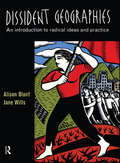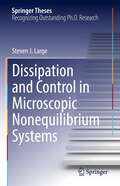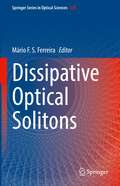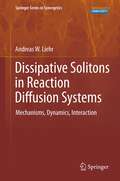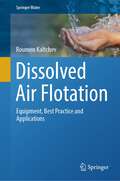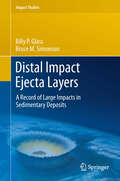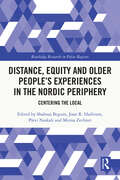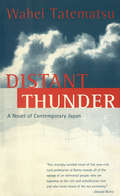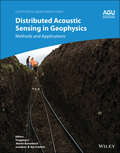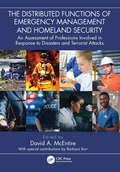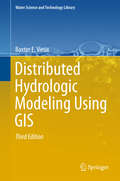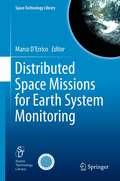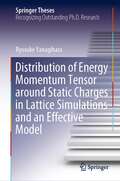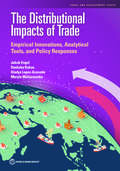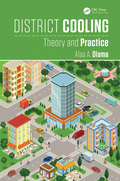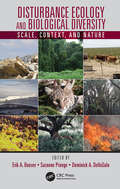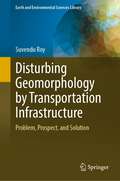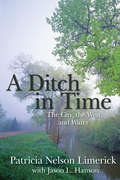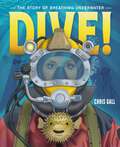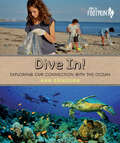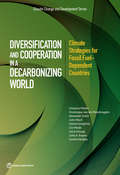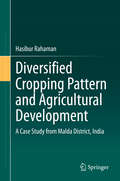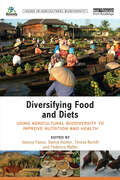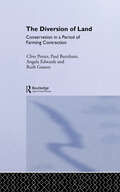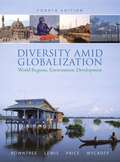- Table View
- List View
Dissident Geographies: An Introduction to Radical Ideas and Practice
by Alison Blunt Jane WillsDissident Geographies is an accessible and lively exploration of radical perspectives in human geography. The perspectives examined in the book reveal and resist certain power relations that have constituted geographical knowledge. The book has two main aims. First, rather than reify 'the' geographical tradition, Dissident Geographies introduces a number of geographical traditions that challenge and destabilize what counts as geographical knowledge. Second, the book shows how the production of geographical knowledge is tied to politics and struggles outside as well as within the academy. In each chapter, case studies illustrate the spatiality of political practice and the politics of geographical thought. In this way Dissident Geographies reveals the connections between power, politics and geographical knowledge.
Dissipation and Control in Microscopic Nonequilibrium Systems (Springer Theses)
by Steven J. LargeThis thesis establishes a multifaceted extension of the deterministic control framework that has been a workhorse of nonequilibrium statistical mechanics, to stochastic, discrete, and autonomous control mechanisms. This facilitates the application of ideas from stochastic thermodynamics to the understanding of molecular machines in nanotechnology and in living things. It also gives a scale on which to evaluate the nonequilibrium energetic efficiency of molecular machines, guidelines for designing effective synthetic machines, and a perspective on the engineering principles that govern efficient microscopic energy transduction far from equilibrium. The thesis also documents the author’s design, analysis, and interpretation of the first experimental demonstration of the utility of this generally applicable method for designing energetically-efficient control in biomolecules. Protocols designed using this framework systematically reduced dissipation, when compared to naive protocols, in DNA hairpins across a wide range of experimental unfolding speeds and between sequences with wildly different physical characteristics.
Dissipative Optical Solitons (Springer Series in Optical Sciences #238)
by Mário F. S. FerreiraThis book introduces the basic concept of a dissipative soliton, before going to explore recent theoretical and experimental results for various classes of dissipative optical solitons, high-energy dissipative solitons and their applications, and mode-locked fiber lasers.A soliton is a concept which describes various physical phenomena ranging from solitary waves forming on water to ultrashort optical pulses propagating in an optical fiber. While solitons are usually attributed to integrability, in recent years the notion of a soliton has been extended to various systems which are not necessarily integrable. Until now, the main emphasis has been given to well-known conservative soliton systems, but new avenues of inquiry were opened when physicists realized that solitary waves did indeed exist in a wide range of non-integrable and non-conservative systems leading to the concept of so-called dissipative optical solitons. Dissipative optical solitons have many unique properties which differ from those of their conservative counterparts. For example, except for very few cases, they form zero-parameter families and their properties are completely determined by the external parameters of the optical system. They can exist indefinitely in time, as long as these parameters stay constant. These features of dissipative solitons are highly desirable for several applications, such as in-line regeneration of optical data streams and generation of stable trains of laser pulses by mode-locked cavities.
Dissipative Solitons in Reaction Diffusion Systems
by Andreas W. LiehrWhy writing a book about a specialized task of the large topic of complex systems? And who will read it? The answer is simple: The fascination for a didactically valuable point of view, the elegance of a closed concept and the lack of a comprehensive disquisition. The fascinating part is that field equations can have localized solutions exhibiting the typical characteristics of particles. Regarding the field equations this book focuses on, the field phenomenon of localized solutions can be described in the context of a particle formalism, which leads to a set of ordinary differential equations covering the time evolution of the position and the velocity of each particle. Moreover, starting from these particle dynamics and making the transition to many body systems, one considers typical phenomena of many body systems as shock waves and phase transitions, which themselves can be described as field phenomena. Such transitions between different level of modelling are well known from conservative systems, where localized solutions of quantum field theory lead to the mechanisms of elementary particle interaction and from this to field equations describing the properties of matter. However, in dissipative systems such transitions have not been considered yet, which is adjusted by the presented book. The elegance of a closed concept starts with the observation of self-organized current filaments in a semiconductor gas discharge system. These filaments move on random paths and exhibit certain particle features like scattering or the formation of bound states. Neither the reasons for the propagation of the filaments nor the laws of the interaction between the filaments can be registered by direct observations. Therefore a model is established, which is phenomenological in the first instance due to the complexity of the experimental system. This model allows to understand the existence of localized structures, their mechanisms of movement, and their interaction, at least, on a qualitative level. But this model is also the starting point for developing a data analysis method that enables the detection of movement and interaction mechanisms of the investigated localized solutions. The topic is rounded of by applying the data analysis to real experimental data and comparing the experimental observations to the predictions of the model. A comprehensive publication covering the interesting topic of localized solutions in reaction diffusion systems in its width and its relation to the well known phenomena of spirals and patterns does not yet exist, and this is the third reason for writing this book. Although the book focuses on a specific experimental system the model equations are as simple as possible so that the discussed methods should be adaptable to a large class of systems showing particle-like structures. Therefore, this book should attract not only the experienced scientist, who is interested in self-organization phenomena, but also the student, who would like to understand the investigation of a complex system on the basis of a continuous description.
Dissolved Air Flotation: Equipment, Best Practice and Applications (Springer Water)
by Roumen KaltchevThis book provides an overview of the dissolved air flotation clarification technology. It brings together the three strands of knowledge and experience accumulated in this field - the analysis of the main phenomena involved and the interactions between them, the equipment for its implementation and its main applications in water treatment. The author draws attention to the design and operation of the different equipment used in practice, their advantages, and disadvantages in the different fields of application of this technology.The book is intended for:•Engineers and technicians working on the design of equipment and its integration into the overall water treatment plant as well as in the operation of flotation plants.•Consultants and engineering offices, hoping that it will help them to make the most appropriate choices regarding the applications of this process, as well as in the equipment selections.•Wastewater treatment plants operators, in the hope that it will help them to optimise the operation of their plants and improve their understanding and analysis of some problems they may encounter.•Purchasers and contractors, who have to make sometime difficult choices for reducing costs and, at the same time, ensure and guarantee the long-term performance and reliability of the plant.The book is oriented towards the practical side of implementing the technology. It contains a lot of information about the equipment (much more than in all other available publications on the same subject) as well as practical comments and recommendations that are very rarely found in this kind of book, written mostly by researchers. It will appeal to specialists who are comfortable with water chemistry, but it may also be of interest to water professionals who are more interested in the equipment, design and operation of water treatment plants.
Distal Impact Ejecta Layers
by Billy P. Glass Bruce M. SimonsonImpact cratering is an important geological process on all solid planetary bodies, and, in the case of Earth, may have had major climatic and biological effects. Most terrestrial impact craters have been erased or modified beyond recognition. However, major impacts throw ejecta over large areas of the Earth's surface. Recognition of these impact ejecta layers can help fill in the gaps in the terrestrial cratering record and at the same time provide direct correlation between major impacts and other geological events, such as climatic changes and mass extinctions. This book provides the first summary of known distal impact ejecta layers
Distance, Equity and Older People’s Experiences in the Nordic Periphery: Centering the Local (Routledge Research in Polar Regions)
by Shahnaj Begum Joan R. Harbison Päivi Naskali Minna ZechnerThis book demonstrates how the largely neglected and multifaceted concept of distance can be used as a primary lens to expand and enrich our understandings of what older people say about their lives, needs and wishes in diverse surroundings in the Northern periphery and beyond. It asks how physical, social and emotional distances shape older people’s everyday lives and practices. Contributions from leading experts provides interdisciplinary investigations into the experiences and stories of older people in the Northern periphery. These insights demonstrate the utility of the concept, distance, when reflecting on the central aspects of contemporary ageing societies. The book explores key themes such as care, age politics, technology, intergenerational relations and migration, providing perspectives that are applicable across a variety of international geographical contexts. This innovative book offers a valuable theoretical and methodological contribution with critical new perspectives on ageing in relation to distances. It will be of interest to students and scholars interested in sociology, human geography, health and social care, ageing and gerontological studies, gender studies and Arctic studies.
Distant Thunder
by Wahei TatematsuWinner of the Noma Prize for New WritersSet in rural Japan at the height of the bubble economy, Distant Thunder tells of a farming village gradually effaced by urbanization, corruption, and greed. After Matsuzo Wada has sold off the family's lands and left his wife for another woman, his son Mitsuo is determined to support himself and his mother in the traditional manner, farming. All that remains of his ancestors' lands is a hothouse, in which he grows tomatoes to sell to the housewives from the nearby apartment complex, built on a former rice field. When his childhood friend, Koji, becomes entangled in an adulterous love affair which ultimately destroys him and those around him, Mitsuo begins to see how the town's hedonistic excesses are laying to waste not only the landscape, but also the communal and familial bonds and the values that once sustained them all.Translated from the Japanese by Lawrence J. Howell and Hikaru Morimoto.
Distributed Acoustic Sensing in Geophysics: Methods and Applications (Geophysical Monograph Series #268)
by Yingping Li Martin Karrenbach Jonathan B. Ajo-FranklinDistributed Acoustic Sensing in Geophysics Distributed Acoustic Sensing in Geophysics Methods and Applications Distributed Acoustic Sensing (DAS) is a technology that records sound and vibration signals along a fiber optic cable. Its advantages of high resolution, continuous, and real-time measurements mean that DAS systems have been rapidly adopted for a range of applications, including hazard mitigation, energy industries, geohydrology, environmental monitoring, and civil engineering. Distributed Acoustic Sensing in Geophysics: Methods and Applications presents experiences from both industry and academia on using DAS in a range of geophysical applications. Volume highlights include: DAS concepts, principles, and measurements Comprehensive review of the historical development of DAS and related technologies DAS applications in hydrocarbon, geothermal, and mining industries DAS applications in seismology DAS applications in environmental and shallow geophysics The American Geophysical Union promotes discovery in Earth and space science for the benefit of humanity. Its publications disseminate scientific knowledge and provide resources for researchers, students, and professionals.
The Distributed Functions of Emergency Management and Homeland Security: An Assessment of Professions Involved in Response to Disasters and Terrorist Attacks
by David A. McEntireThe Distributed Functions of Emergency Management and Homeland Security outlines the roles and responsibilities of various individuals and agencies involved in homeland security and all aspects of emergency management. Each chapter focuses on the practical and applied aspects of a range of public servants in various departments and the organizations that they represent. Rather than presenting a theoretical exploration alone, the book examines the practical knowledge and hands-on skills related to various functions and how their decisions and actions play into the larger framework of safety and security —in the public, private and nonprofit sectors. Every professional has a unique and integral part to play in fulfilling their roles and obligations, whether it be in relation to prevention, mitigation, preparedness, response or recovery operations. Personnel that frequently come to mind in such scenarios include emergency managers, geographers and land-use planners, EMTs and paramedics, fire fighters, police officers, public health officials, nurses, public administrators, and public information officers. And while these individuals are integral to homeland security and emergency management, there are other professionals that also perform essential duties that—while they aren’t first-to-mind—are vital to efforts relating to terrorism and disasters; this includes pilots in the aviation sector, the military, attorneys, psychologists, and forensic professionals serving in pathology, DNA, and dentistry roles. Chapters provide a holistic rendering of the homeland security and emergency management landscape to present all these various professional capabilities and contributions. This includes how current functions are coordinated as well as how future efforts might change relative to a more proactive, all-hazards and holistic approach. As such, the book will be a useful resource for students and practitioners to understand the dynamic professions—and various disciplines and fields—that impact disaster and terrorism preparedness and response capabilities.
Distributed Hydrologic Modeling Using GIS
by Baxter E. VieuxThis book presents a unified approach for modeling hydrologic processes distributed in space and time using geographic information systems (GIS). This Third Edition focuses on the principles of implementing a distributed model using geospatial data to simulate hydrologic processes in urban, rural and peri-urban watersheds. The author describes fully distributed representations of hydrologic processes, where physics is the basis for modeling, and geospatial data forms the cornerstone of parameter and process representation. A physics-based approach involves conservation laws that govern the movement of water, ranging from precipitation over a river basin to flow in a river. Global geospatial data have become readily available in GIS format, and a modeling approach that can utilize this data for hydrology offers numerous possibilities. GIS data formats, spatial interpolation and resolution have important effects on the hydrologic simulation of the major hydrologic components of a watershed, and the book provides examples illustrating how to represent a watershed with spatially distributed data along with the many pitfalls inherent in such an undertaking. Since the First and Second Editions, software development and applications have created a richer set of examples, and a deeper understanding of how to perform distributed hydrologic analysis and prediction. This Third Edition describes the development of geospatial data for use in Vflo(r) physics-based distributed modeling.
Distributed Space Missions for Earth System Monitoring
by Marco D'ErricoThis title analyzes distributed Earth observation missions from different perspectives. In particular, the issues arising when the payloads are distributed on different satellites are considered from both the theoretical and practical points of view. Moreover, the problems of designing, measuring, and controlling relative trajectories are thoroughly presented in relation to theory and applicable technologies. Then, the technological challenges to design satellites able to support such missions are tackled. An ample and detailed description of missions and studies complements the book subject.
Distribution of Energy Momentum Tensor around Static Charges in Lattice Simulations and an Effective Model (Springer Theses)
by Ryosuke YanagiharaThe energy momentum tensor (EMT) is one of the most fundamental observables in physics. Recently, a novel method to define EMT on the basis of the gradient-flow formalism has been proposed. It turned out that the EMT operator can be constructed even on the lattice with the method, which enables non-perturbative computations. This approach has been successfully applied to the analyses on thermodynamic quantities.This book presents the study on spatial EMT distributions around static charges via the gradient flow in lattice simulations based on SU(3) Yang-Mills theory. Static charges are employed as probes to explore complex quantum systems, and EMT then characterizes the response of vacuum as well as hot medium under the existence of the charges, which significantly provides profound and novel insights into the non-perturbative phenomena, such as the confinement of quarks. In addition, the book treats the study on the EMT distribution around a magnetic vortex in the Abelian-Higgs model, which is compared with the lattice result. These achievements open up various future studies for revealing non-trivial aspects of the strong interaction.The book also includes well-organized reviews on general properties of EMT, lattice gauge theory and the gradient-flow formalism with its application to the definition of EMT. They are useful for students and young researchers as a brief introduction to this field.
The Distributional Impacts of Trade: Empirical Innovations, Analytical Tools, and Policy Responses (Trade and Development)
by Jakob Engel Deeksha Kokas Gladys Lopez-Acevedo MaliszewskaTrade is a well-established driver of growth and poverty reduction.But changes in trade policy also have distributional impacts that create winners and losers. It is vital to understand and clearly communicate how trade affects economic well-being across all segments of the population, as well as how policies can more effectively ensure that the gains from trade are distributed more widely. The Distributional Impacts of Trade: Empirical Innovations, Analytical Tools, and Policy Responses provides a deeper understanding of the distributional effects of trade across regions, industries, and demographic groups within countries over time. It includes an overview (chapter 1); a review of innovations in empirical and theoretical work covering the impacts of trade at the subnational level (chapter 2); highlights from empirical case studies on Bangladesh, Brazil, Mexico, South Africa, and Sri Lanka (chapter 3); and a policy agenda to improve distributional outcomes from trade (chapter 4). This book comes at a time when the shock from COVID-19 (coronavirus) adds to an already uncertain trade policy environment in which the value of the multilateral trading system has been under increased scrutiny. A better understanding of how trade affects distributional outcomes can lead to more inclusive policies and support the ability of countries to maximize broad-based benefits from trade.
District Cooling: Theory and Practice (Heat Transfer #7)
by Alaa A. OlamaDISTRICT COOLING: THEORY and PRACTICE provides a unique study of an energy cogeneration system, set up to bring chilled water to buildings (offices, apartment houses, and factories) needing cooling for air conditioning and refrigeration. In winter, the source for the cooling can often be sea water, so it is a cheaper resource than using electricity to run compressors for cooling. The related technology of District Heating has been an established engineering practice for many years, but District Cooling is a relatively new technology now being implemented in various parts of the world, including the USA, Arab Emirates and Kuwait, and Saudi Arabia. Existing books in the area are scarce, and do not address many of the crucial issues facing nations with high overall air temperatures, many of which are developing District Cooling plans using sea water. DISTRICT COOLING: THEORY & PRACTICE integrates the theory behind district cooling planning with the practical engineering approaches, so it can serve the policy makers, engineers, and planners whose efforts have to be coordinated and closely managed to make such systems effective and affordable. In times of rising worldwide temperatures, District Cooling is a way to provide needed cooling with energy conservation and sustainability. This book will be the most up-to-date and comprehensive study on the subject, with Case Studies describing real projects in detail.
Disturbance Ecology and Biological Diversity: Context, Nature, and Scale
by Erik A. Beever Inger Suzanne Prange Dominick A. DellaSalaThis book presents cascading effects of ecological disturbances on a multitude of ecosystem components. It includes agricultural development, large infrequent disturbances, forest harvesting, non-native grazing in deserts, ground transportation, powerline corridors, fires, urban ecology, disturbance in aquatic ecosystems, land-use dynamics on diversity, habitat fragmentation, sedimentation of wetlands, and contemporary climate change. The book facilitates users in understanding why disturbances are occurring while recommending mitigation and remediation strategies.
Disturbing Geomorphology by Transportation Infrastructure: Problem, Prospect, and Solution (Earth and Environmental Sciences Library)
by Suvendu RoyThis book focuses on a significant branch of anthropogeomorphology, which is not adequately studied: the impact of transportation systems on altering earth surface processes and landforms. This book fills the gap with in-depth study on the interaction between individual modes of transport network (e.g., trail, roads, railways, waterways, airports, and tunnel) and surface hydro-geomorphology with intensive literature review, fieldwork, geo-environmental modelling, mapping, case studies, and examples from different parts of the world. On the one hand, this book also addresses the vulnerability of transport networks from climate change and critical geo-hazards like floods, landslides, etc. with case studies from the high-risk zones of India. Overall, this book promotes peaceful harmony between the transport network and its surrounding landscapes as an essential lesson for policymakers, planners, and stakeholders.
A Ditch in Time
by Jason Hanson Patricia Nelson LimerickThe history of water development . . . offers a particularly fine post for observing the astonishing and implausible workings of historical change and, in response, for cultivating an appropriate level of humility and modesty in our anticipations of our own unknowable future. Tracing the origins and growth of the Denver Water Department, this study of water and its unique role and history in the West, as well as in the nation, raises questions about the complex relationship among cities, suburbs, and rural areas, allowing us to consider this precious resource and its past, present, and future with both optimism and realism. Patricia Nelson Limerick is the faculty director and board chair of the Center of the American West at the University of Colorado, where she is also a professor of history and environmental studies. She currently serves as the vice president for the teaching division of the American Historical Association. Her most widely read book, The Legacy of Conquest, is in its twenty-fifth year of publication.
Dive!: The Story of Breathing Underwater
by Chris GallDIVE! is a fascinating introduction to the comprehensive world history of diving by award-winning artist Chris Gall.How do you breathe underwater? What tools can we use to go deeper and deeper into the oceans? And...what's down there?Two-thirds of our Earth is covered in ocean, yet only 5% of it has been explored. DIVE deep into our long history of sea exploration to learn why, how, and when humans have dived, and uncover our biggest questions about what hides in the Earth's deepest waters.Perfect for STEM-oriented minds and young and old readers fascinated by the sea, Dive! is a must-have to add to any nonfiction shelf.
Dive In!: Exploring Our Connection with the Ocean (Orca Footprints #14)
by Ann ErikssonWe're all connected to the ocean, and the ocean to us. The ocean provides half the oxygen we breathe; it feeds us, creates our weather and provides us with water. But we haven't been as kind to the ocean in return. The problems are many: pollution, overfishing, rising seas and acid waters. What can be done? Don't despair; take action. Dive In! explores our intimate connection with the ocean and provides every reader with an achievable set of actions that can help improve ocean health for our sake and the sake of the millions of marine plants and animals that share the planet with us. Filled with colorful photos and positive stories, Dive In! is as informative as it is inspirational.
Diversification and Cooperation in a Decarbonizing World: Climate Strategies for Fossil Fuel-Dependent Countries (Climate Change and Development)
by Grzegorz Peszko Dominique van der Mensbrugghe Alexander Golub Ward Cor Marijs Anne Schopp John Rogers Amelia MidgleyThis book is the first stocktaking of what the decarbonization of the world economy means for fossil fuel†“dependent countries. These countries are the most exposed to the impacts of global climate policies and, at the same time, are often unprepared to manage them. They depend on the export of oil, gas, or coal; the use of carbon-intensive infrastructure (for example, refineries, petrochemicals, and coal power plants); or both. Fossil fuel†“dependent countries face financial, fiscal, and macro-structural risks from the transition of the global economy away from carbon-intensive fuels and the value chains based on them. This book focuses on managing these transition risks and harnessing related opportunities. Diversification and Cooperation in a Decarbonizing World identifies multiple strategies that fossil fuel†“dependent countries can pursue to navigate the turbulent waters of a low-carbon transition. The policy and investment choices to be made in the next decade will determine these countries’ degree of exposure and overall resilience. Abandoning their comfort zones and developing completely new skills and capabilities in a time frame consistent with the Paris Agreement on climate change is a daunting challenge and requires long-term revenue visibility and consistent policy leadership. This book proposes a constructive framework for climate strategies for fossil fuel†“dependent countries based on new approaches to diversification and international climate cooperation. Climate policy leaders share responsibility for creating room for all countries to contribute to the goals of the Paris Agreement, taking into account the specific vulnerabilities and opportunities each country faces.
Diversified Cropping Pattern and Agricultural Development: A Case Study from Malda District, India
by Hasibur RahamanThis book examines how crop diversification strategies can help to ensure sustainable agricultural development across different land-size categories, with a focus on Malda District in West Bengal, India. Using Malda as the study area, a region with nearly 4 million people, the book assesses the extent, pattern, factors and future of crop diversification and its contribution to the development of agriculture in Malda and in India as a whole. The work presents data from 1995-2015 concerning changing cropping patterns at various land-size distributions, and analyzes the information over the twenty year period to understand the link between crop diversification and agricultural development, in order to combat major agricultural issues and make suitable policy recommendations at micro (rural) and macro (urban) levels of agricultural planning. The study is a unique contribution to the field of agricultural geography, and will be of use to students and researchers, as well as government organizations, city/community planners and agriculture managers.
Diversifying Food and Diets: Using Agricultural Biodiversity to Improve Nutrition and Health (Issues in Agricultural Biodiversity)
by Danny Hunter Federico Mattei Jessica Fanzo Teresa BorelliCurrently 868 million people are undernourished and 195 million children under five years of age are stunted. At the same time, over 1 billion people are overweight and obese in both the developed and developing world. Diseases previously associated with affluence, such as cancer, diabetes and cardio-vascular disease, are on the rise. Food system-based approaches to addressing these problems that could enhance food availability and diet quality through local production and agricultural biodiversity often fall outside the traditional scope of nutrition, and have been under-researched. As a consequence, there remains insufficient evidence to support well-defined, scalable agricultural biodiversity interventions that can be linked to improvements in nutrition outcomes. Agricultural biodiversity is important for food and nutritional security, as a safeguard against hunger, a source of nutrients for improved dietary diversity and quality, and strengthening local food systems and environmental sustainability. This book explores the current state of knowledge on the role of agricultural biodiversity in improving diets, nutrition and food security. Using examples and case studies from around the globe, the book explores current strategies for improving nutrition and diets and identifies key research and implementation gaps that need to be addressed to successfully promote the better use of agricultural biodiversity for rural and urban populations and societies in transition.
The Diversion of Land: Conservation in a Period of Farming Contraction (The Natural Environment: Problems and Management)
by Clive Potter Bryn Green Angela Edwards C. Paul Burnham Ruth GassonEuropean agriculture is on the brink of a financial and ecological crisis. The authors assess the challenge facing policy makers and those involved in the industry, arguing for the preparation of an environmental agenda based on land organisation and diversion.
Diversity Amid Globalization 4th Edition
by Lester Rowntree Martin Lewis Marie Price William WyckoffThe globalization approach challenges students to make critical comparisons between the regions of the world in order to understand them more fully. Examples of the sorts of topics used to accomplish these goals include: The rise of Islamic fundamentalism in SW Asia. Aboriginal groups using high-technology tools to forge common political survival strategies. The economic and political integration of the European Union, contrasted with micronationalism and the factionalism in Europe. Ethnic diversification in the face of strong participation in the global assembly line in SE Asia. The globalization and localization of beer consumption and production in the United States and Canada.
